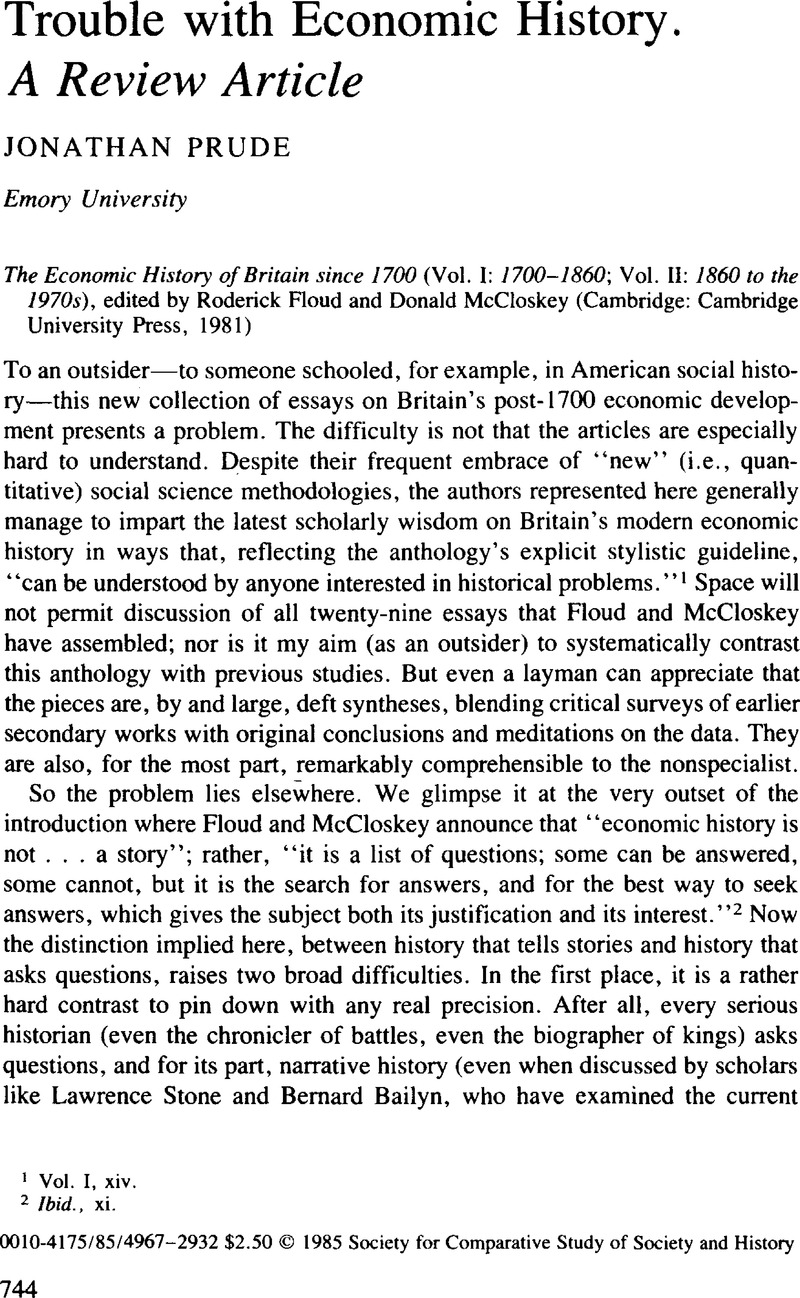No CrossRef data available.
Article contents
Trouble with Economic History. A Review Article
Published online by Cambridge University Press: 03 June 2009
Abstract

- Type
- Explanations in Economic History
- Information
- Copyright
- Copyright © Society for the Comparative Study of Society and History 1985
References
1 Vol. I, xiv.Google Scholar
2 Ibid., xi.
3 Stone, L., “The Revival of Narrative: Reflections on a New Old History,” Past and Present, 85 (09 1979), 3–24.CrossRefGoogle ScholarRallyn, B., “The Challenge of Modern Historiography, ” American Historical Review, 87 (02 1982), 1–24.Google Scholar
4 Vol. I, xiv, 1. The editors acknowledge that “much has been left out” of their collection but only in order to “concentrate on the topics which are most problematical and yet where solutions… may be attainable.” The anthology's coverage, we are led to believe, has not suffered from the selectivity.
5 The only departure from this structure is ch. 5, the essay by R. P. Thomas and D. N. McCloskey on “Overseas Trade and Empire,” which covers the whole 1700–1860 period,
6 Vol. I, 1.
7 Ibid., 17, 54, 62, 68. We may note in passing that the Lee and Schofield essay, for all its strengths, leaves the classic conundrum of what caused the post-1740 surge in population somewhat up in the air and characterizes as “unresolved” the related (and equally central) problem of whether population increases produced or responded to economic expansion. See pp. 31–35.
8 Ibid., 104, 108, 142. McCloskey stresses (pp. 116–7) that while “great inventions” such as mule spinning, power weaving, steam traction, and the steam engine deserve attention, the more modest tinkering, “improvements,” and “ordinary inventiveness” that pervaded Britain during this era were also of crucial importance.Google Scholar
9 Ibid., 202–3.
10 Ibid., 167–71, 173–75, 178–79, 211–12ff.
11 Ibid., 11, 71–72, 83–84.
12 See, for example, McKendrick, N., Brewer, J. and Plumb, J. H., The Birth of Consumer Society: The Commercialization of Eighteenth-Century England (Bloomington, 1982).Google Scholar
13 Bailyn, , “The Challenge of Modern Historiography,” 9–11.Google Scholar
14 Vol. I, 110–11. The often-criticized employment of women and children is also downplayed. Thus, Cole mentions the phenomenon only to stress that its effect would have been to increase per capita income (by increasing total family wages) while granting employers “the pleasant experience” of rising demand coupled with the “falling unit labour costs” stemming from low female and child wages (Ibid., 71–72). O'Brien and Engerman acknowledge child labor but stress that physical size and literacy were both increasing in Britain and that, in the end, industrialization made child labor unnecessary (Ibid., 176–77). Finally, Tranter emphasizes that the over-all infusion of women and children into the wage labor force was relatively small (Ibid., 210).
15 Ibid., 180–81. A relatively up-to-date introduction to the English standard-of-living debate, containing both optimistic and pessimistic views (the former including an earlier essay coauthored by Engerman) is found in Taylor, A. J., ed., The Standard of Living in Britain in the Industrial Revolution (London, 1975)Google Scholar. Among the more important recent pessimistic statements are Hobsbawm, E. J., “The British Standard of Living, 1790–1850,” Economic History Review, 2d ser. (08 1957), 46–61CrossRefGoogle Scholar; Thompson, E. P., The Making of the English Working Class (New York, 1963), ch. 5.Google Scholar
16 Vol. I, 100, 43, 45, 63, 120–22. For another view on the role of foreign trade and the Empire, see Hobsbawm, E. J., Industry and Empire (London, 1968), ch. 2.Google Scholar
17 On Britain's preindustrial economy see, e.g., Berg, M., Hudson, P. and Sonenscher, M., Manufacture in Town and Country before the Factory (Cambridge, 1983), I, 117, 119.CrossRefGoogle Scholar
18 Vol. I, 109, 226, 275.
19 Vol. II, 1.
20 Thus, A. Briggs' essay on social history and I. Drummond's treatment of “Britain and the World Economy” span the whole 1900–1945 period. N. von Tunzelmann's survey is entitled “Britain 1900–45,” but in fact deals almost exclusively with the interwar period.
21 Vol. II, 197, 3, 24–25, 376.
22 Ibid., 143, 18, 173–74, 145–46, 116, 119, 82, 64–69. On the value of overseas investment, see also I. Drummond's discussion, e.g., pp. 289ff.
23 Ibid., 19, 88–97, 69, 25.
24 Ibid., 293–304, 324–26. Alford, in fact, argues for an endemic inertia: “[B]y virtue of Britain's early start and the long span and relatively slow pace of her industrialization, the required changes, in political and social institutions which had become so entrenched over the years, as well as in the structure of industry itself, were particularly difficult to achieve.…”
25 Ibid., 254 (but see also p. 331), 256–58, 276–84, 382–84, 414, 408. We should note that there is general consensus that, even if Keynes's policies had been fully implemented, they would not have cured unemployment. We may note too that T. Thomas's article on “Aggregate Demand in the United Kingdom, 1918–45” is one piece which, perhaps inevitably (since it is a careful working through of the Keynsian model), does overpower the lay reader with equations.
26 Ibid., 25, 415.
27 See, e.g., Genovese, E., The Political Economy of Slavery: Studies in the Economy and Society of the Slave South (New York, 1965)Google Scholar; Hahn, S., The Roots of Southern Populism: Yeoman Farmers and the Transformation of the Georgia Upcountry (New York, 1983)Google Scholar; Danhof, C. H., Change in Agriculture: The Northern United States 1820–1870 (Cambridge, Mass., 1969)Google Scholar; Clark, C., “The Household Economy, Market Exchange, and the Rise of Capitalism in the Connecticut Valley, 1800–1860,” Journal of Social History, 13 (Winter 1979), 169–89CrossRefGoogle Scholar; and Prude, J., The Coming of Industrial Order: Town and Factory Life in Rural Massachusetts, 1810–1860 (New York, 1983).Google Scholar
28 Vol. I, xiv.
29 Vol. II, 25.




